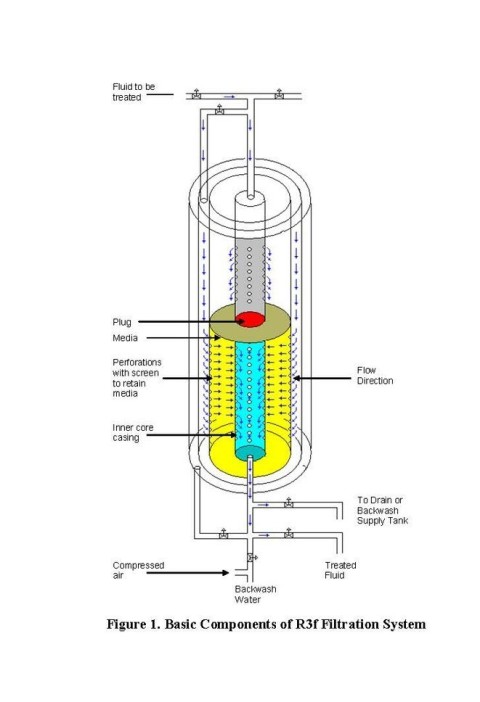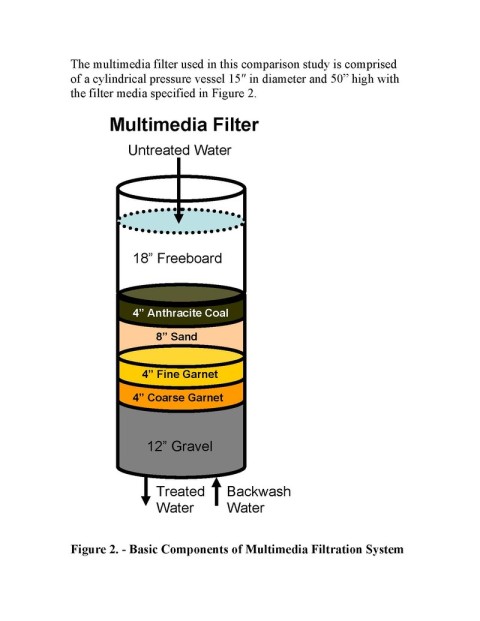
Craig Patterson EPA
Radial Flow Fluidized Filter Finds Niche as a Pretreatment System for Surface Water in Small Communities
Craig Patterson, P.E., U.S. EPA, Cincinnati, OH, patterson.craig@epa.gov
An emerging technology called radial flow fluidized filter (R3f) has been developed as a low cost simplistic filtration technology for small communities of less than 10,000 people. Fouling is a major impediment to the sustainability of membrane technology particularly for small potable water treatment system applications. The main culprit for fouling is dissolved organic carbon (DOC). Enhanced coagulation, to remove DOC prior to membrane application, has reduced fouling and organic carbon levels significantly. If chlorine is used, removing DOC also reduces the formation of disinfection byproducts. However, small communities typically do not have highly trained operators or financial resources to use high dosages of coagulants. Alternative filtration technologies are needed to reduce operation and maintenance costs in small communities.
Filtration Technologies
Small communities can choose from several alternative filtration technologies.
1. Screen or fixed barrier filtration systems
2. Disposable final filters
3. Membranes.
4. Multimedia filters
Screens or fixed barrier filters provide a coarse filter for the removal of particles larger than 25 microns. Fixed screens are self cleaning filtration systems that require large volumes of backwash water. Particles can lodge in the screen (particle pegging) causing problems during backwash and reduced flux rates.
Membranes and disposable final filters (depth, bag, and cartridge filters) serve as a final filtration barrier for potable water systems by providing sub micron particle removal without the use of coagulants. Membranes and final filters may require pretreatment to be cost effective. Membranes are effectively restored with chemicals involving labor intensive clean-in-place operations and media backwash.
Multimedia filters are typically comprised of coarse anthracite, silica sand, fine garnet sand and gravel as a support medium. The coarse anthracite media removes most of the suspended solids and those particles that pass through are removed by the sand and garnet media below. Expanding the media during backwash easily frees the trapped particles unless media has solidified or mud balls have formed. The use of pretreatment chemistry such as metal coagulants or polymers increases small particle removal (>95%) in the 2 to 3 micron size range.
Research Comparing R3f and Multimedia Filters
The US EPA Office of Research and Development in Cincinnati, Ohio and Enprotec of Hebron, KY are comparing multimedia and emerging R3f filtration technologies. Both technologies are low cost operationally simplistic alternatives to membrane filtration. Turbidity, particle and microbial removal studies are being conducted to evaluate filter performance and to determine compliance with the drinking water standards mandated by the Safe Drinking Water Act.
The Ref system is comprised of two liters of non bonded garnet media (33 micron size) for depth filtration. A typical R3f Tube is 150 mm (6 inches) in diameter and 1.8 m (6 feet) high as shown in Figure 1. The media can be fluidized and backwashed very quickly resulting in backwash volumes significantly lower than other technologies.
Results indicate that the R3f system performs significantly better than the conventional multimedia filtration system without the use of chemical coagulants. Turbidity tests on the R3f system resulted in effluent turbidity levels of approximately 0.5 nephelometric
turbidity units (NTU) from influent feed water with turbidity levels of 5 NTU and 10 NTU. The R3f system compared to an average log removal of 0.2 for the multimedia filter when both systems were operated without the use of chemistry. One verification run was performed on the R3f system using Cryptosporidium oocysts resulting in a 3.47 log removal value.
The R3f fits a niche between sub-micron and coarse filtration ( 1 to 25 micron particle size range ), where filtration can be provided without the use of coagulants for particle pretreatment and destabilization. This operationally simplistic filtration technology is suitable for small community potable water systems with flow rates between 5 and 400 gallons per minute. It can also serve as a prefilter to membranes (nanofilters and reverse osmosis systems) or a prefilter to disposable final filter systems.
This article is one of a regular series of reports on emerging and innovative technologies in the area of environment and water resources produced by EWRI’s Emerging and Innovative Technologies Committee (EITC). EITC’s mission is to advance the development, knowledge, and application of emerging and innovative technologies for the planning and management of water resources and the protection and enhancement of the environment. If you are interested in contributing an article or becoming a member of this Committee, please contact Walter Grayman at grayman@fuse.net.


